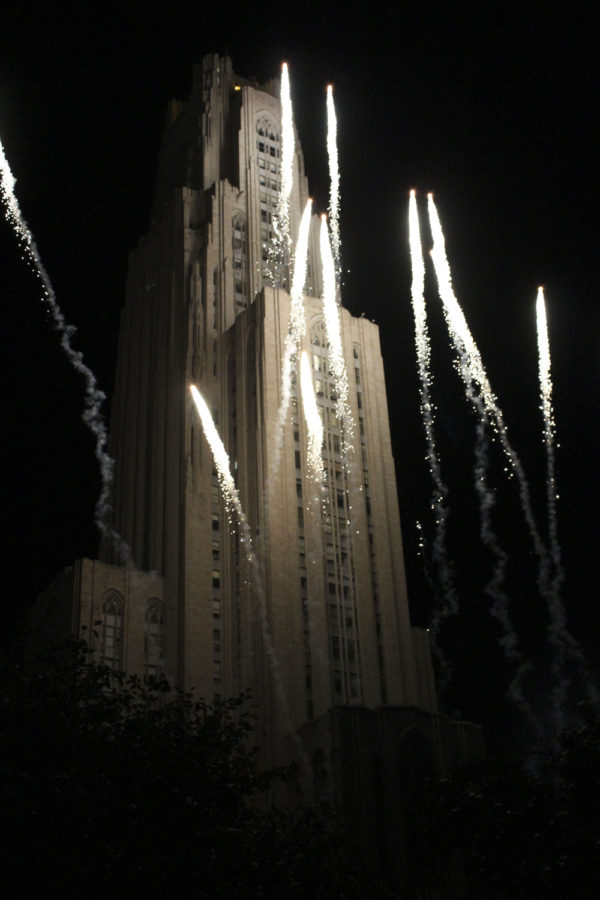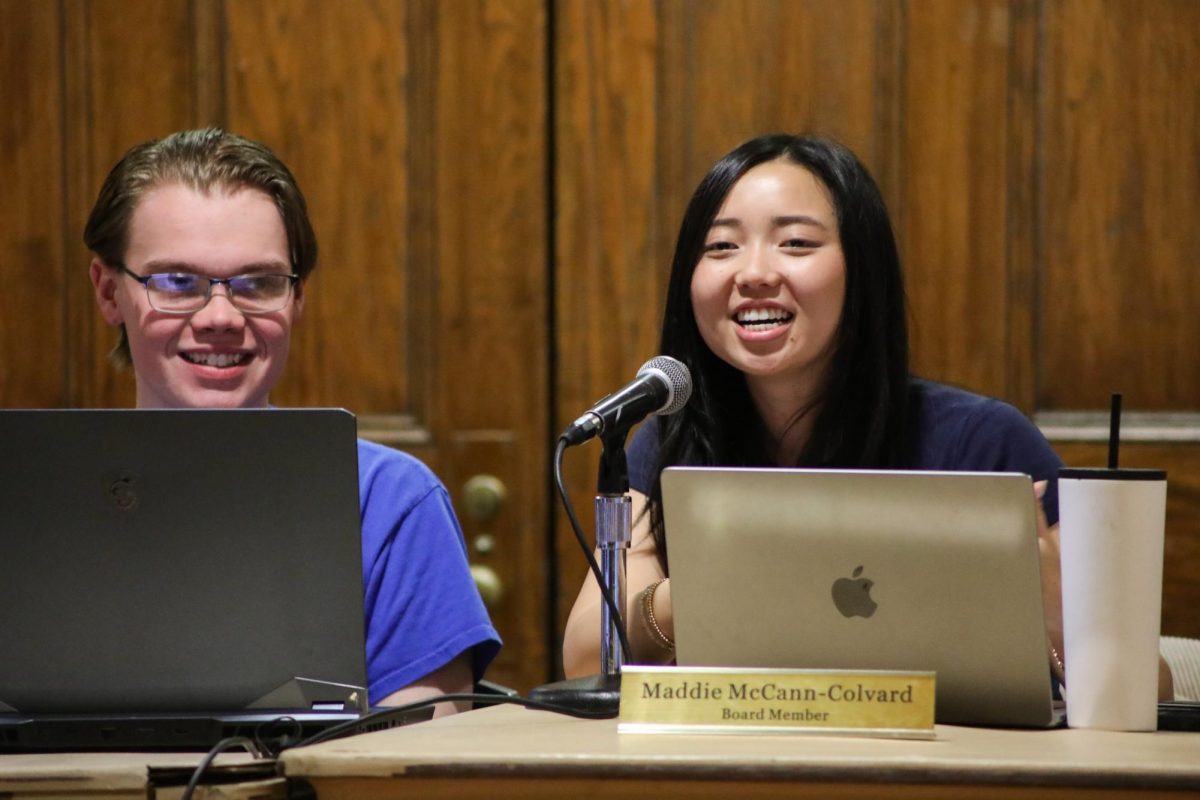Behind the scenes: PPC’s explosive homecoming tradition
Sarah Cutshall | Staff Photographer
Fireworks lit up the Cathedral of Learning last October for Courtside at the Cathedral — a celebratory event for homecoming and the season commencement for Pitt’s basketball teams.
October 4, 2018
Bigelow Boulevard will briefly go completely dark at 9 o’clock Friday evening. Faculty, students and electrical company officials will extinguish every light in and around the Cathedral — creating a blank, black canvas for an explosive display of light and sound.
Pitt’s week of homecoming traditions has included a Friday-night laser and firework show since 1990, when Pitt Program Council’s faculty adviser Tom Misuraca was inspired by a similar show at Epcot in Disney World.
“Lasers and fireworks, all synchronized to music, lighting that changes … it’s the best in the world,” Misuraca said of the show at Epcot. “I said to the students, ‘What would you think about doing a show like that instead?’”
Pitt’s annual homecoming parade, held between 1955 and 1988, brought problems for PPC. The parade was expensive. Closing the streets of Oakland for the parade to pass by was difficult. And because Oakland didn’t have space to hold flatbed trucks for students to decorate in the weeks leading up to the parade, it didn’t include student-made floats.
By the late 1980s, PPC was looking for alternatives. That’s when Misuraca suggested a fireworks display like the IllumiNations fireworks show at Epcot that had launched a few years earlier.
So PPC replaced its Friday-night parade with a laser and fireworks show — one that looked much different than this Friday’s will. It featured only green lasers — today they’re multicolored — and there were no pyrotechnics on the Cathedral of Learning itself.
“You only had so many lasers, so you would bounce them off of mirrors to make them look like you had more,” Misuraca said. “Technology has changed significantly.”
In the show’s current form, after a lively finale of music, lasers and fireworks, the Cathedral lights up in silence for 30 seconds, followed by a laser panther stalking up one side of the Cathedral and down the other — a feature that has become a signature of the night.
A picture of the Cathedral lit up in red, taken the first year there were pyrotechnics on the building itself, hangs on the wall of Misuraca’s office.
“You need to see it from the middle of the street,” he said.
Niki Iyer, PPC’s executive director, said she likes to stand on Bigelow and watch other people watch the show.
“This is one of the best moments to people-watch,” Iyer said. “There are certain surprises that you don’t know are going to happen and then all of a sudden, it happens! It gives me a lot of joy to see other people acting like a little kid again.”
Each summer, students on PPC make a list of songs they think would suit the show. Misuraca takes songs from that list, along with a few from his own favorite artists, and creates a show around them, picking out moments in the music with a particular energy and matching them to fireworks. Misuraca relies largely on his instincts here, he said.
“It’s ears and eyes,” he said. “Nobody gets to hear the soundtrack before the show.”
Once Misuraca decides to use a song, he has to cut it down to below a minute and a half. All the technical pieces required to bring the show together safely make it difficult for Pitt students to be directly involved in the process, but this step is one they can help with.
Iyer, who has served as PPC’s executive director since the beginning of last year, edited the shortened version of Ed Sheeran’s “Galway Girl” that played during last year’s show. She has edited two more songs for this year.
“You want songs that make anyone, alumni or students, go, ‘Oh my God, I know this song!’ and start dancing,” she said.
Misuraca takes the completed track list and meets separately with representatives from Zambelli Fireworks — located in Warrendale, which has provided the show’s fireworks since its first year — and the laser company Lightwave, which has a local office in Washington County.
“Tom has an excellent knowledge of fireworks, and a lot of ideas of what he’d like to see happening in the display,” Kim Ceyrolles, the project manager at Zambelli who worked with Misuraca on this year’s show, said in an email.
PPC uses Zambelli Fireworks at its annual bonfire and pep rally as well. Pitt’s 30-year partnership with Zambelli is part of a long, rich history for the company that began in New Castle, PA in 1893.
Lightwave is a newer company, but it has its own claim to fame — the Phenom Laser. The Phenom is a lightweight, high-tech laser that the company debuted in 2014. With the Phenom, Lightwave can send beams scanning over the crowd without endangering the audience. The company’s operating manager, John Walker, said Pitt’s show uses the Phenom alongside more standard beams and projectors.
“It’s an industry exclusive,” Walker said. “Nobody else has anything like that.”
Ceyrolles sends the script — complete with the exact timing of fireworks to music — to Zambelli’s plant in Edinburg, where the fireworks are packed. On the day of the show, Zambelli technicians unpack the fireworks at Mazeroski Field across from Schenley Plaza. Then, shortly before the show begins, police close down Bigelow and laser technicians set up screens and lasers.
Keeping the show safe is a laborious process with a lot of moving pieces. The 3-inch firework shells require a 300-foot radius clear of people and vehicles in every direction from the field, so nearby street parking is closed on the day of the show.
University engineers stand on the roofs of Mervis Hall, Posvar Hall and the Frick Fine Arts Building with fire extinguishers at the ready for embers that land on the roofs. A fire truck pumps a mist onto Schenley Plaza’s tent to ensure it won’t catch fire. And that’s just the beginning, Misuraca said.
“This is a thumbnail of what we do for safety,” Misuraca said.
Twenty-five minutes after the first fireworks flare up in the sky, the show ends. The lights on the street come back on so the audience can walk to their next destinations in safety. A year of work comes to an end and the process of dismantling begins.
“The minute after this year’s show, we’ll start working on next year’s,” Misuraca said.



